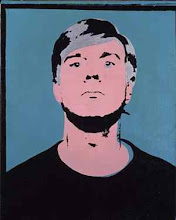 |
| Jackson Pollock, Mural, 1943 (Click on image to enlarge) |
Jackson Pollock’s Mural: Energy Made Visible is at Deutsche Bank KunstHalle, Berlin until 10
April 2016.
This
small but focused exhibition contextualises Mural painted by Jackson Pollock in 1943/4 for a commission from Peggy Guggenheim. The painting, owned
by the University of Iowa Museum of Art (UIMA) was bequeathed to them by Peggy
Guggenheim. In the 1940s Guggenheim ran a gallery in New York called ‘Art of This Century’ which specialised in exhibiting European Surrealism and the young
American artists who were to become the New York School – the Abstract
Expressionists. In 1943 Pollock signed a contract with the gallery and was
commissioned to make a mural for the entrance hall of Guggenheim’s new
apartment in Manhattan. As the UIMA website recounts:
The
choice of subject was to be his, and the size, immense—8' 1 1/4" x 19'
10", meant to cover an entire wall. At the suggestion of Guggenheim's
friend and advisor Marcel Duchamp, it was painted on canvas, not the wall itself,
so it would be portable. Pollock wrote of his commission that it was:
"...with
no strings as to what or how I paint it. I am going to paint it in oil on
canvas. They are giving me a show November 16 and I want to have the painting
finished for the show. I've had to tear out the partition between the front and
middle room to get the damned thing up. I have it stretched now. It looks
pretty big, but exciting as all hell." […]
Pollock
spent weeks staring at the blank canvas, complaining to friends that he was
"blocked," and seeming to become both obsessed and depressed.
Finally, according to all reports, he painted the entire canvas in one frenetic
burst of energy around New Year's Day of 1944—although the painting bears the
date 1943… As soon as the canvas was dry to the touch, Pollock broke down the
stretcher, rolled the canvas, and transported both to Guggenheim's townhouse.
Some accounts have said that the painting was too long for the space by almost
a foot, and when Pollock discovered this he became quite hysterical. Marcel
Duchamp and another artist were said to have cut eight inches from one end
before it was installed. However, close examination by numerous experts over
the years has revealed no evidence of this.
The
other legend associated with this commission – but which no ‘serious’ accounts
of Pollock seem to include – is that at the polite party thrown by Guggenheim
at the unveiling of Mural Pollock got drunk and stumbled into the
living room, where guests had already gathered to celebrate the installation,
unzipped his fly, and urinated into Peggy’s marble fireplace. (Wetzsteon,
R. (1988) Republic of Dreams: Greenwich Village: The American Bohemia,1910-1960, Simon & Schuster, p531).
The
painting itself is impressive – and, historically, something of a game changer,
opening the door to large scale, full blown abstraction. UIMA notes that
Clement Greenberg, destined to become the authoritative critical spokesman for
Abstract Expression had written encouraging but less than whole-hearted endorsements
in his Pollock reviews, but, he said after he saw the big mural in Guggenheim's
townhouse, "I took one look at it and I thought, 'Now that's great art,'
and I knew Jackson was the greatest painter this country had produced."
(Click on images to enlarge.)
 |
| Herbert Matter, Jackson Pollock standing in front of 'Mural', c1947 |
 |
| George Kargar, Peggy Guggenheim and Jackson Pollock in fron of 'Mural', 1943 |
The
exhibition includes several other paintings, notably by Lee Krasner and RobertMotherwell as well as interesting archive material and a display of
contemporary photography experimenting with abstraction and the representation
of movement. (Although it pains me to say so, a painting by Andy Warhol is
probably the least interesting thing here!)
 |
| Robert Motherwell, Elegy to the Spanish Republic No.126, 1965-75 |
 |
| Lee Krasner, Another Storm, 1963 |
 |
László
Moholy-Nagy, Pink, Red anity Lights, 1937-40
|
 |
| Aaron Siskind, Chicago 8, 1948 |
 |
| Andy Warhol, Yarn Painting, 1983 |










No comments:
Post a Comment